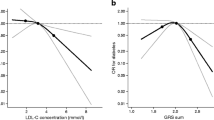Abstract
Objective: To identify genetic factors related to individual differences in lipid responses to intensified treatment in Type 2 diabetes. Design and Methods: After evaluation and intensification of their treatment, 107 Type 2 diabetes patients with poor metabolic control were re-evaluated after mean follow-up time of 15.6 (0, 4) (SE) months. The genes coding major lipid regulatory proteins and their relations to plasma lipid and lipoprotein changes were studied. Results: During the follow- up, levels of glycohemoglobin A1 (GHBA1) decreased (−1.7%), plasma HDL cholesterol (+0.05 mmol/l) and lipoprotein (a) [Lp(a)] (+4.2 mg/dl) increased, while triglyceride (TG) levels decreased (−1.2mmol/l) despite mean weight gain of 2.1 kg (p from <0.01 to <0.001). Of the gene markers studied, the lipoprotein lipase (LPL) PvuII (p=0.005) independently affected changes in HDL-cholesterol and was associated with the frequency of coronary heart disease (CHD). Lp(a) changes were associated with apolipoprotein B (ApoB) Glu4154Lys polymorphism (p=0.004). Conclusions: These results suggest that genetic variations at LPL and ApoB loci are among the factors contributing to the variability in response to lipid parameters to therapy in Type 2 diabetes. LPL PvuII rare allele homozygote status seems to be beneficial with more favorable lipid changes and protection against CHD.
Similar content being viewed by others
References
Howard BV. Lipoprotein metabolism in diabetes mellitus. J Lipid Res 1987, 28: 613–28.
Nikkilä EA. High density lipoproteins in diabetes. Diabetes Care 1981, 30 (Suppl 2): 82–7.
Taskinen M-R, Kuusi T, Helve E, Nikkilä EA, Yki-Järvinen H. Insulin therapy induces antiatherogenic changes of serum lipoproteins in noninsulin-dependent diabetes. Arteriosclerosis 1988, 8: 168–77.
Masson LF, McNeill G, Avenell A. Genetic variation and the lipid response to dietary intervention: a systematic review. Am J Clin Nutr 2003, 77: 1098–111.
Rantala M, Rantala TT, Savolainen MJ, Friedlander Y, Kesäniemi YA. Apolipoprotein B gene polymorphism and serum lipids: meta-analysis of the role of genetic variation in responsiveness to diet. Am J Clin Nutr 2000, 71: 713–24.
Ukkola O, Kervinen K, Salmela PI, von Dickhoff K, Laakso M, Kesäniemi YA. Apolipoprotein E phenotype is related to macro- and microangiopathy in patients with non-insulin- dependent diabetes mellitus. Atherosclerosis 1993, 101: 9–15.
Menzel H-J, Utermann G: Apolipoprotein E phenotyping from serum by Western blotting. Electrophoresis 1986, 7: 492–5.
Lipid Research Clinics Manual of Laboratory Operations. Lipid and lipoprotein analysis. Department of Health, Education and Welfare (U.S.). Publication (National Institutes of Health) 1974, 1: 75–82.
Miller SA, Dykes DD, Polesky HF. A simple salting out procedure for extracting DNA from human nucleated cells. Nucleic Acids Res 1988, 16: 1215.
Juvonen T, Savolainen MJ, Kairaluoma MI, Lajunen LH, Humphries SE, Kesaniemi YA. Polymorphisms at the apoB, apoA-I, and cholesteryl ester transfer protein gene loci in patients with gallbladder disease. J Lipid Res 1995, 36: 804–12.
Ukkola O, Savolainen MJ, Salmela PI, von Dickhoff K, Kesäniemi YA. DNA polymorphisms at the lipoprotein lipase gene are associated with macroangiopathy in type 2 (non-insulin-dependent) diabetes mellitus. Atherosclerosis 1995, 115: 99–105.
Ukkola O, Savolainen MJ, Salmela PI, von Dickhoff K, Kesäniemi YA. DNA polymorphisms at the locus for human cholesteryl ester transfer protein (CETP) are associated with macro- and microangiopathy in non-insulin-dependent diabetes mellitus. Clin Genet 1994, 46: 217–27.
Jackson RL. Lipoprotein lipase and hepatic lipase. In: Boyer P ed. The enzymes. New York: Academic Press. 1983, 16: 141–81.
Eckel RH. Lipoprotein Lipase. In: Borensztajn J ed. Chigaco, IL: Evener Press. 1987, 79-132.
Oka K, Tkalcevic GT, Nakano T, Tucker H, Ishimura-Oka K, Brown WV. Structure and polymorphic map of human lipoprotein lipase gene. Biochim Biophys Acta 1990, 1049: 21–6.
Scanu AM, Fless GM. Lp(a): heterogeneity and biological relevance. J Clin Invest 1990, 85: 1709–15.
Scanu AM. Atherothrombogenicity of lipoprotein (a): the debate. Am J Cardiol 1998, 82: 26Q–33Q.
Dunning AM, Tikkanen MJ, Ehnholm C, Butler R, Humphries SE. Relationships between DNA and protein polymorphisms of apolipoprotein B. Hum Genet 1988, 78: 325–9.
Ma YH, Schumaker V, Butler R, Sparkes R. Two DNA restriction fragment length polymorphisms associated with Ag(tz) and Ag(cg) antigenic sites of human apolipoprotein B. Arteriosclerosis 1987, 71: 301–5.
Author information
Authors and Affiliations
Corresponding author
Rights and permissions
About this article
Cite this article
Ukkola, O., Salonen, J. & Kesäniemi, Y.A. Role of candidate genes in the lipid responses to intensified treatment in Type 2 diabetes. J Endocrinol Invest 28, 871–875 (2005). https://doi.org/10.1007/BF03345317
Accepted:
Published:
Issue Date:
DOI: https://doi.org/10.1007/BF03345317




